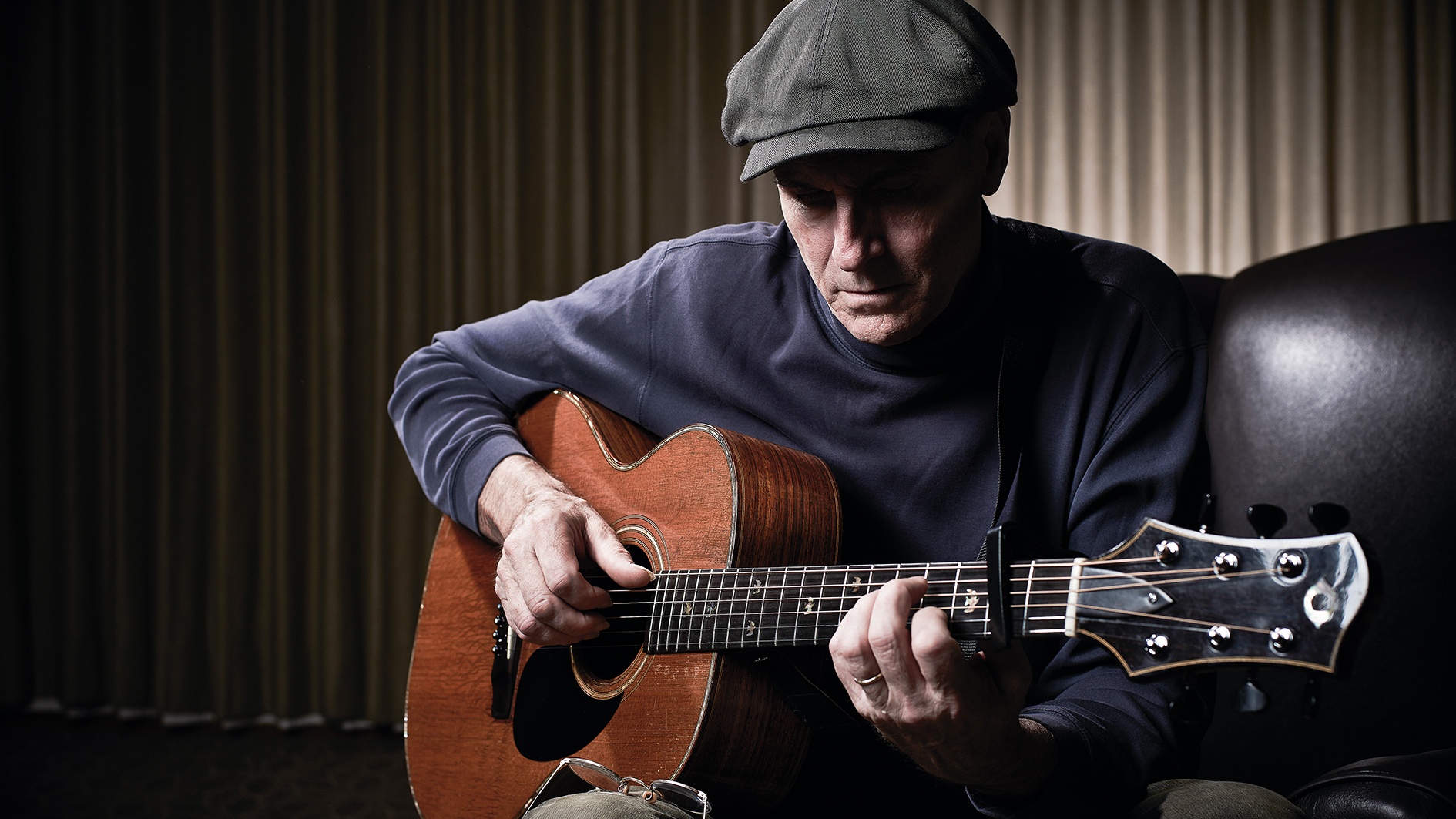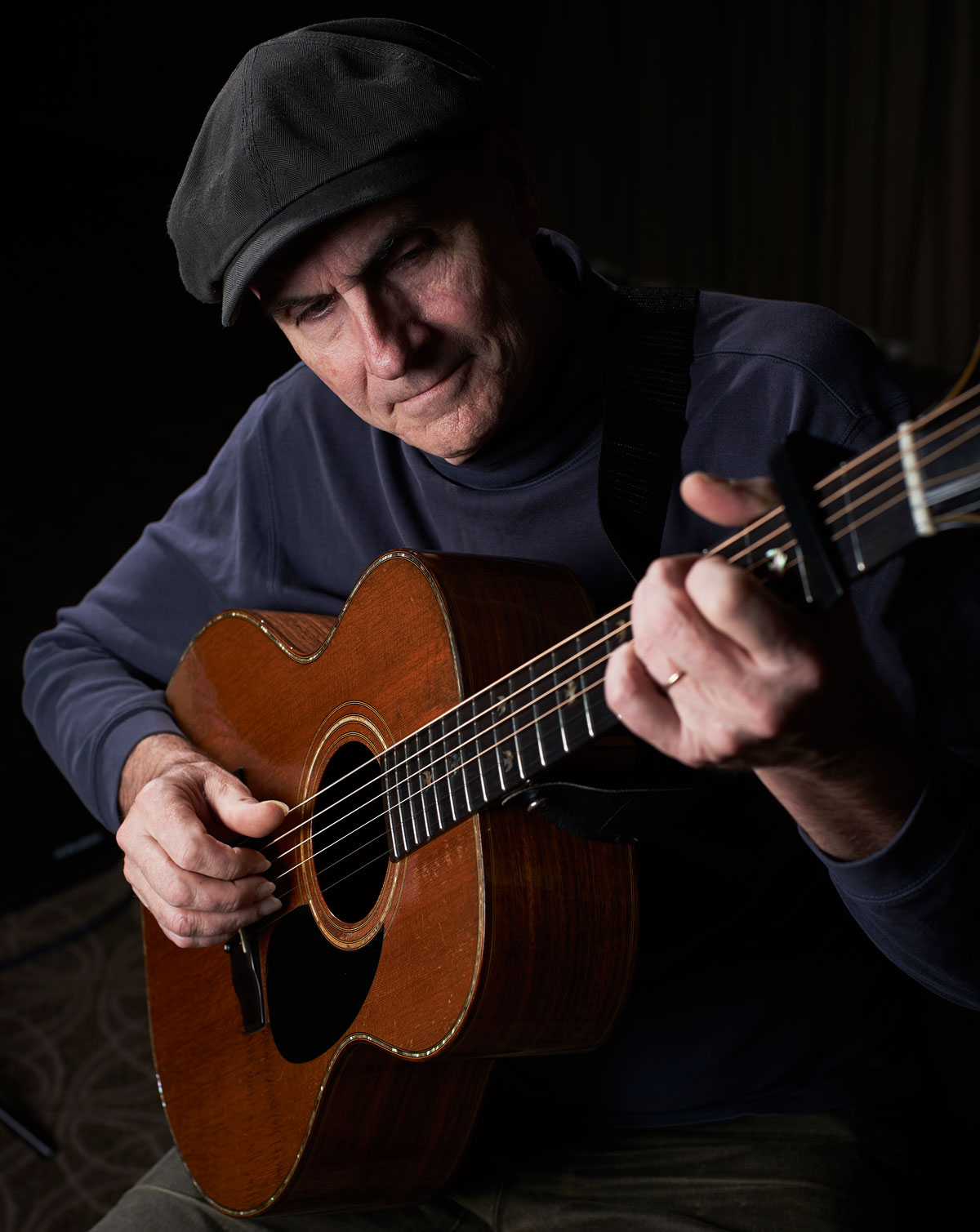James Taylor: "American Standard is a guitar album - I’ve had some of these arrangements since I started playing"
We get the lowdown on the arrangement, composition and recording of the original singer-songwriter's new covers album American Standard, including a full track breakdown

If we exclude the insightful protest songs of Bob Dylan, mostly played over simplistic backings, the pithy words and harmonically sophisticated arrangements of Paul Simon, or the often wistful, sometimes jazzy but always poetically sublime meanderings of Joni Mitchell, then James Taylor is the archetypal singer- songwriter-guitarist.
An often troubled intellectual, Taylor’s masterstroke was in putting deeply personal lyrics, sometimes clear but often cryptic, onto a country-folk musical backdrop with deft and hooky acoustic guitar picking at its core.
In a way, he’s the stealth bomber of the music world. A bona-fide superstar with 100 million album sales to his credit (every release from JT in 1977 to 2006’s James Taylor At Christmas has gone Platinum), Taylor has a self-effacing demeanor that still sends women swooning and men trotting off to the guitar shop - and vice versa, we’re sure.
His latest release, American Standard, takes a formula first laid down by Willie Nelson with Somewhere Over The Rainbow in 1981, then Linda Ronstadt’s What’s New in 1983, and taken up by everyone from Robbie Williams (Swing When You’re Winning, 2001) to Rod Stewart, who’s built a second career out of it, and created an album of American Songbook classics.
Of course, as with everything he does, Taylor has gently but powerfully laid his stamp all over it. As his producer Dave O’Donnell says, “When James covers a song it sounds like he wrote it.”
O’Donnell couldn’t be more right. James uses his tried-and trusted chord voicings and fretboard moves, and weaves them around tunes that could have been written for his milestone JT album of 1977, the Grammy-winning Hourglass that came two decades later, or his No 1 release Before This World in 2015.
“It is a guitar album,” states James in typically clipped fashion. “I purposefully didn’t iterate it with a keyboard. We were very careful to keep the guitar as the centre of each arrangement, because these are arrangements of my own.
Get The Pick Newsletter
All the latest guitar news, interviews, lessons, reviews, deals and more, direct to your inbox!
"I’ve had some of these since I started playing the guitar. I learnt to play playing these songs that I knew from childhood.
My generation drew a distinct line between ourselves and what sounded to us like Vegas or in any way ‘lounge-y’. It’s like folk music was okay and Celtic music was okay, but Sinatra was not
“But it’s interesting. When my generation stepped out and were making themselves known, we drew a distinct line between ourselves and what sounded to us like Vegas or in any way ‘lounge-y’. It’s like folk music was okay and Celtic music was okay, but Sinatra was not. We were unkind and unaccepting of that music. We distanced ourselves from it.
"And, in fact, it’s so fabulous. We did them a disservice. People like Bobby Darin tried to change his stripes and become Bob Darin, and found himself on the wrong side of the generational divide.
"But that changed when Willie Nelson made his standards album. And Linda Ronstadt, who actually worked with Nelson Riddle. That changed things. It made it possible for Rod Stewart. And now Natalie Cole, of course - she’s the real deal; she actually is a jazz singer [Natalie passed away in 2015].
“But on each album I tend to have a cover of some sort. And I recorded an album of covers [Covers, 2008] which had Oh, What A Beautiful Mornin’ on. So I’ve done a number of these tunes, what are thought of as American Songbook. They are songs of the 1920s, 30s and 40s, with a couple from the 50s in there. They are the previous generation’s music.

“But this is the music that informed Lennon-McCartney, Paul Simon, Randy Newman, Joni Mitchell. The people of our generation listened to this stuff when they were kids, and I think that it really informed their harmonic sense. It’s much more sophisticated than music has become.
“I think the difference is that these were written as songs to be done by anyone. These days what we listen to are performances. In other words, we are listening to a specific person, a specific voice, and you wouldn’t think of them being covered by other people, generally speaking.
“[Back then], they didn’t have production values that would dazzle us, and they didn’t know who would be performing the song, so it had to exist as a set of changes, a lyric and a melody. So, in my opinion, they are the high watermark of popular music.”
These were written as songs to be done by anyone... they are the high watermark of popular music
Taylor and the brilliant jazz guitarist John Pizzarelli worked out the core of the guitar arrangements for the album, which must have been an interesting challenge.
“Yes, we did work them out together,” Taylor concurs. “I’m playing my Olson guitars and Pizzarelli is mostly playing a seven-string. So there’s some bass notes that are coming out of the guitars that are outside of the usual range. But they’re my arrangements.
"With my limited guitar technique I’ve managed to interpret these tunes. It works for John to augment those. It doesn’t work for John to give me changes and to have me play them. He’s much more suited to accommodating me than I am suited to accommodating him. And, fortunately for me, I’m calling the shots.
“But, yes, it was a very interesting process. I thought we were doing demos to start with. Then the idea occurred to me, ‘Let’s make this into a guitar project.’ Because you can tend to have a kind of cookie-cutter experience when making this kind of album.

"You can get a great rhythm section and a really strong arranger, but it can sound like these songs often tend to sound. When I do a cover I basically try to adapt my technique and my voice to the material, and when it works it does. I really wanted to keep that at the centre of it.
"If we’d asked a piano player to interpret these changes then had an arranger orchestrate them, it would have somehow obscured what is actually happening here. Which is that I’m running these songs through my process. There are some that it works with and some that it doesn’t - these are the ones that work.”
To keep an essentially acoustic album from sounding same-y, Taylor and his team added instruments from outside the main band. Things like saxophone, melodica, Dobro, violin, and harmony vocals lend color and interest.
When I do a cover I basically try to adapt my technique and my voice to the material... I really wanted to keep that at the centre of it
“After John and I cut these basic tracks we took them to my musical community, and that’s basically the guys that I tour with and record with [James’s band comprises Jimmy Johnson, bass; Steve Gadd, drums; Larry Goldings, keys; Lou Marini, clarinet, sax]. I also have a relationship with Jerry Douglas [Dobro] and Stuart Duncan [violin], and for the first time I worked with Viktor Krauss [upright bass].
"We worked for an awfully long time, getting the arrangements down. And I took it to my vocalists [Arnold McCuller, Kate Markovitz, Dorian Holley, Andrea Zonn] and we found parts for them on three of the songs to sing. So, yes, I sort of took it through the garden.”
When two guitarists arrange songs on acoustics one imagines capos at various positions on each instrument, with each player adopting different inversions of the chords. Not so in this case, apparently.

“John is a proper guitar player,” Taylor states, modestly. “He very seldom uses a capo. He is free on the neck with all of the inversions. I’m pretty much stuck in the first position, so I use a capo a lot. My guitar tech, Jon Prince, wrote down all of the capo positions, so that tells you what the fingering is.
"Often it’s either G [shape], many of them are A, there’s a couple in E and a number in D. And there are actually some where I change capo position for the bridge. I’ll get JP to send them to you.” James kindly did this and the key and capo position are listed beside each song in the track-by-track interview that follows...
Singing the songbook
1. My Blue Heaven
Key: C, Capo 3rd fret
This opening track on American Standard begins with a separate verse, a typical songwriting device of that time that we seem to have lost...
“It was the way the song was introduced into the action of a musical, or a little way of setting it up. A bit of conversation that’s not yet the body of the song. They’re great; some of them are really smart. It basically sets the stage a little bit. A number of the songs that I play, I go from the swung thing to a straight eight thing, and it’s the straight eight that sounds like Latin. We actually brought in Luis Conte on percussion to make that clear.”
2. Moon River
Key: Bb, Capo 1st fret
James hasn’t exactly re-harmonized this, but there are some interesting things going on - he seems to have twisted it a little bit. There’s a Stevie Wonder-esque solo that sounds like a harmonica, but isn’t...
“This particular track is just the two guitars, there’s no rhythm. So the only other thing aside from my voice is a six-string guitar, a seven-string guitar, and a solo that Larry Goldings is playing. It sounds like a harmonica, but actually it’s a melodica.
"Actually, in many cases I wrote these solos. I gave the players lines to play, and Larry starts with my melody and then goes off on his own and that’s when it rises up and breaks free of it. If it sounds like Stevie Wonder, I think it’s probably more likely that Stevie and I have the same source, which is Ray Charles. That informs Stevie’s music - at least I think it does.”
3. Teach Me Tonight
Key: B, Capo 2nd fret
This song has lyrics by the incomparable Sammy Cahn, with music by Gene De Paul and was published in 1953. Five different versions charted in 1954 and 1955 alone.
“Yes, Sammy Cahn and Gene De Paul. We’ve cast this with something of a Latin feel and, again, got Luis Conte to play maracas and congas on it. Walt Fowler plays some beautiful trumpet on it, too. It’s a simple piece and it’s essentially a simple album.”
4. As Easy As Rolling Off A Log
Key: A, Capo 2nd fret
There’s an almost Django-esque swing to this song, which James first heard on the kids’ cartoon Katnip Kollege. The tasty guitar fills are also by James, but he has a confession...
“I play that introduction into the clarinet on the guitar. But it’s a studio artefact. I couldn’t play it in real-time. I jumped in and constructed it, edited it together really. This song came from a cartoon that I remember from when I was a kid. When I told Kootch [old friend and collaborator Danny Kortchmar] that I’d cut that song, he said, ‘Yes, you were always going on about that song.’”
5. Almost Like Being In Love
Key: G, Capo 3rd fret
Here the harmony vocals come in, lifting both the song and the album. Typical JT chords such as major 9ths and #5ths show that songs like this clearly informed his own writing.
“Yes, they definitely did. Nat King Cole’s version of this song was my favorite, but I knew it from the musical Brigadoon. It was one of those ones that I learnt early on and basically taught me the chords that are in it.”
6. Sit Down, You’re Rocking The Boat
Chorus: Key: B, Capo 1st fret; Intro: Key: Abm, Capo 2nd fret
Readers may remember Stubby Kaye’s brilliant original from Guys And Dolls. The fabulous Jerry Douglas guests on Dobro here, which works a treat.
“This doesn’t have the energy that Stubby Kaye’s version had, and that’s because that’s a cast album version. It’s live and the tempo is way up and he’s singing it like he’s got a trumpet in his throat. So our approach was to get intricate with it and the harmonies, and we spent a lot of time writing these harmony parts that are in there. It was a lot of fun, that tune.”
7. The Nearness Of You
Key: E, Capo 2nd fret
There’s a kind of Herb Alpert feel to this, with James’s favorite chord moves the perfect bed for some succinct trumpet solo and fills.
“That’s Walt Fowler, who tours with me. He popped it into double time and he did lift it, did a great job on it. The same thing with Lou Marini on Almost Like Being In Love; that’s a line that I asked him to play, a line I’ve heard for years as something I’ve wanted to hear in that place.
"That really opens it up, too. It’s a song that I’d already recorded with Pat Metheny and Michael Brecker. It’s a Hoagy Carmichael, so it was probably written on the guitar. My favorite chord changes do fall right into it. It was part of my DNA and part of my vocabulary.”
8. You’ve Got To Be Carefully Taught
Key: D, No capo
This song from the 1958 musical South Pacific is powerfully anti-racist. Coming from that time it must have been an incredibly brave song to write.
“I think so. The lyric is angry. It’s cynical and talking about making children hate, teaching them when they’re young and innocent. So it is a pretty brutal thing when you get right down to it. That’s a song that John Pizzarelli brought to the project. He said, ‘You know this one.’ I said, ‘You bet I do,’ and played it immediately on the guitar for him.”
9. God Bless The Child
Key: C, Capo 3rd fret; No capo on second half of bridge
This Billie Holiday classic is really a sophisticated blues. And she made a fantastic version of it.
“Absolutely right, it is. I played the song with Kootch and Joel O’Brien and Zach Wiesner in our band The Flying Machine in 1966. This was part of our repertoire. I’ve lived with the tune for a long time, so it’s been a long time coming.”
10. Pennies From Heaven
Key: A, Capo 2nd fret
The organ sound on this is reminiscent of Nat King Cole’s solo on Let’s Face The Music And Dance.
“It’s the only keyboard on the album that is actually comping, playing along with the chords. Larry Goldings plays a sort of a solo in that tune, and then comes back in the coda, in the fade, and plays the changes with us.”
11. My Heart Stood Still
Key: E, Capo 2nd fret
The chord structure on this song, sung by Frank Sinatra and many others, lends itself perfectly to Taylor’s lyrical style, and is one of those that definitely sounds like he might have written it.
“Yes, this one fell right into place. Lyrics by Lorenz Hart. I think that Hart was a closeted gay guy. A lot of his lyrics have this kind of heartbreak behind them, a kind of a furtiveness, and a ‘dare not speak its name’ kind of thing that you can feel.
"This song explicitly is not definitely homosexual love, but you can feel that doomed energy to it, that sort of ‘this will never happen’. Because the musical theatre was so tolerant of gay people it has such a strong energy to it because of its denial.”
12. Ol’ Man River
Key: Bb, Capo 1st fret
This Jerome Kern and Oscar Hammerstein song from Show Boat was made famous by legendary singer Paul Robeson.
“That’s the definitive version of it, and has connected to it all of that political energy. It’s a very dicey thing for a white guy to sing this song and some of the lyrics. This is an abbreviated version of what’s actually a very long song, but I’ve played it for so many years and loved it so much.
"It’s also amazingly range-y, so I’ll never be able to do it live. It starts with an F, because it’s in Bb. And of course at the end of it, it goes up two and a half octaves. It’s a very difficult song to sing. Also, it walks a line for someone such as me to sing it, but I love the song so much I just couldn’t leave it alone. We put very little on top of this tune; it lives with my guitar and voice.”
13. It’s Only A Paper Moon
Key: A, Capo 2nd fret
Those who knows Taylor’s 1997 album, Hourglass, will recognize some of the chord moves here, particularly in the track Line ’Em Up.
“I did cut Paper Moon before with Don Grolnick for a movie called A League Of Their Own, so I had become familiar with the tune. Kootch and I used to talk about doing the song in kind of a straight eight blues kind of way. But it’s one of those things that fell into the Latin-leaning side of my stuff. And it’s very much the same place as Line ’Em Up.”
14. The Surrey With The Fringe On Top
Key: G tuned down a half-step, Capo 1st fret
This Rodgers and Hammerstein song from the hit musical Oklahoma! (1943) can seem rather throwaway, but harmonically it’s surprisingly sophisticated.
“Yes, it can be. The person who really opened these American Songbook songs up, chordally and harmonically, was Bill Evans. Bill just had that touch of gold. He looked at things and saw harmonies and chord changes in them that have become the standard versions of a lot of songs. The Surrey With The Fringe On Top is an old-fashioned song.
"It’s not a beat that has been in pop music since. It’s got that foxtrot kind of rhythm that’s not a current song. And I actually found it very difficult to sing, because it’s not in any way modern or contemporary.”
In the late '70s and early '80s Neville worked for Selmer/Norlin as one of Gibson's UK guitar repairers, before joining CBS/Fender in the same role. He then moved to the fledgling Guitarist magazine as staff writer, rising to editor in 1986. He remained editor for 14 years before launching and editing Guitar Techniques magazine. Although now semi-retired he still works for both magazines. Neville has been a member of Marty Wilde's 'Wildcats' since 1983, and recorded his own album, The Blues Headlines, in 2019.










